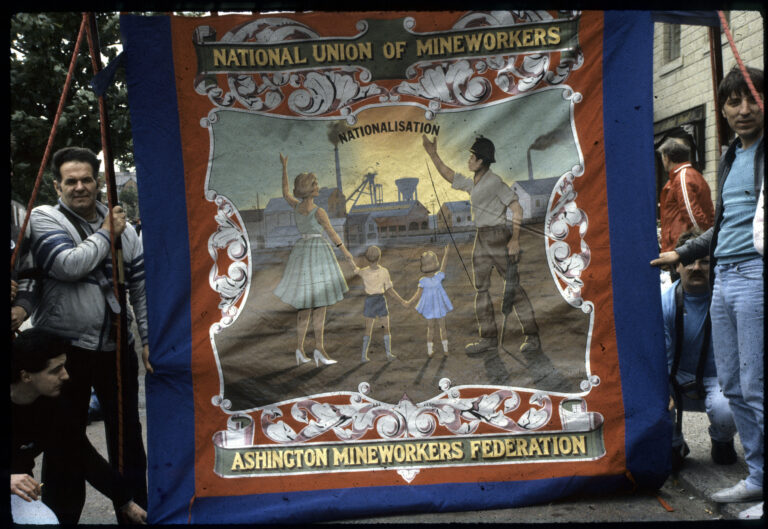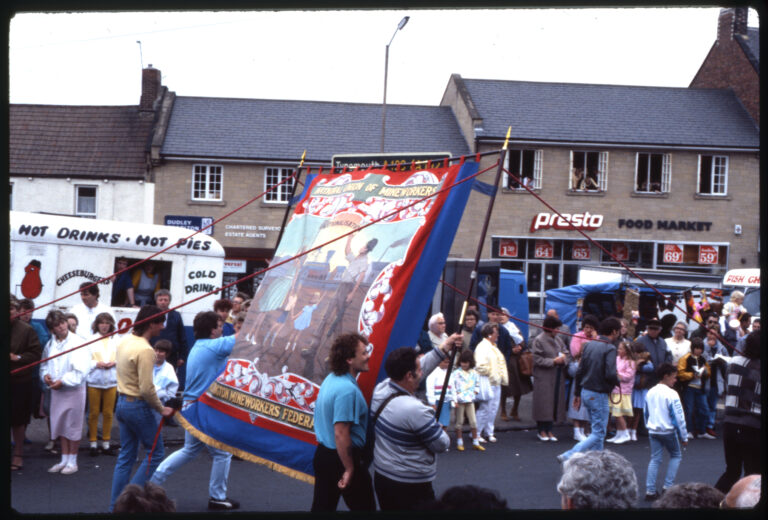Photographs of Ashington Federation Mining Banner, 1988
Reference: NRO 07074/13, 17, 29
Suggested age groups: KS1, KS2, KS3, KS4, Lifelong Learners
Subject areas: History, Geography, Art, Literacy, Politics
CONTEXT
NRO 07074/13 Colour photograph showing the front of the Ashington Federation banner, held by a group of men.
NRO 07074/15 Colour photograph showing the back of the Ashington Federation banner, held by a group of men.
NRO 07074/29 Colour photograph of Ashington Federation banner being carried along the streets of Ashington as part of the Miners’ Picnic.
Trade Unions are organisations that represent a group of employees (or sometimes employers) in a particular job or profession. Trade Unions represent their members in negotiations and disagreements. Trade Unions are often involved in pay discussions as well as campaigning for better working conditions for their members.
Northumberland Miners’ Association (NMA) was formed in 1864. Members paid a subscription (or “subs”) to become a member. In 1944 the NMA became part of National Union of Mineworkers. The motto of the NUM is “The Past We Inherit The Future We Build”.
Banners were paraded at miners’ picnics, during demonstrations and other community events. The Woodhorn banner was created in 1916 and paraded at the miners’ picnic of that year. A few weeks later it was also paraded at the funerals of the men killed in the Woodhorn disaster. If a fatal accident happened at a colliery, the banner for that branch would be draped in black crepe (a fabric often used in mourning clothes) during the picnic parade.
Banners were usually created to represent a union branch (sometimes called lodges) this might include one or a number of collieries. The Ashington Federation banner that can be seen here represented the mines that were owned by the Ashington Coal Company (Ashington, Ellington, Woodhorn, Linton and Lynemouth pits).
Each banner was different, but they tended to have some common features. Banners often had a central panel with an image, a motto and the name of the branch that it represented. The image (or images) in the central panel were often of the local pit buildings but might also be of personalities from the Labour movement (Keir Hardie or Clement Atlee, for example) or scenes from mining life.
The background cloth of the banner tended to be in strong primary colours – often royal blue and scarlet red. The banners were usually highly decorated with scrolls and stylized leaves around the central panel, titles, and mottoes. Both back and front were decorated as they were both seen when on parade.
At least six people (women’s groups had their own banners) were needed to carry a banner. Two people held the poles of the frame that the banner was attached to and four people each held thin ropes attached to the top of the poles to help keep the banner stable. On the photographs here it looks as if two additional men are keeping hold of the corners of the banner – this might have been necessary on a windy day.
ACTIVITIES
ACTIVITY 1
Background
Banners were paraded at miners’ picnics, during demonstrations and other community events. The Woodhorn banner was created in 1916 and paraded at the miners’ picnic of that year. A few weeks later it was also paraded at the funerals of the men killed in the Woodhorn disaster. If a fatal accident happened at a colliery, the banner for that branch would be draped in black crepe (a fabric often used in mourning clothes) during the picnic parade.
Banners were usually created to represent a union branch (sometimes called lodges) this might include one or a number of collieries. The Ashington Federation banner that can be seen here represented the mines that were owned by the Ashington Coal Company (Ashington, Ellington, Woodhorn, Linton and Lynemouth pits).
SEE
See: What is a mining banner?
See: What is shown on these mining banners?
See: What types of imagery and text were typically included on mining banners?
See: What types of colours were used on mining banners?
See: What were mining banners used for?
See: Where were mining banners paraded?
THINK
Think: Why was the Woodhorn banner paraded after the Woodhorn disaster?
Think: Why were mining banners important?
Think: How were mining banners used to convey a message?
Think: What types of messages did mining banners convey?
DO
Do: Analyse the imagery used in the pictured mining banners. What can you infer from them?
Do: Write a one sentence manifesto for the message being conveyed by the pictured mining banners.
Do: Look through examples of mining banners from different areas. What can you learn about different collieries and mining communities from the banners? Were mining communities and mining culture the same across the country or did this differ from place to place?
Do: Use the Northern Mine Research Society interactive map to find the coal mine closest to your local area.
Do: Research your nearest coal mine. Can you find their miners’ banner?
Do: Find stories about your nearest mine and the mining community who lived and worked there.
Do: Create a mining banner to represent the stories of your nearest mine and the community who lived and worked there.
Do: Create a mining banner to represent your school, family, or local area.
Do: Parade your banner.
Do: Look at the miners’ banner created by artist Grayson Perry.
Do: Compare Grayson Perry’s banner to the other miners’ banners you have looked at. What message does Perry’s banner convey? Is this similar or different to other miners’ banners?
Do: Use the Northern Mine Research Society interactive map to choose a former mining community. This could be local to you or further afield.
Do: Research your chosen former mining community to see what the area was like when the mine was thriving. Compare this to the area today. How has the closure of the mines impacted the area – socially, politically, and economically? What is the main industry or employer there today?
Do: Design a banner to represent how your chosen area has evolved over time while celebrating the mining heritage of the area.
Resources
ACTIVITY 2
Background
Trade Unions are organisations that represent a group of employees (or sometimes employers) in a particular job or profession. Trade Unions represent their members in negotiations and disagreements. Trade Unions are often involved in pay discussions as well as campaigning for better working conditions for their members.
Northumberland Miners’ Association (NMA) was formed in 1864. Members paid a subscription (or “subs”) to become a member. In 1944 the NMA became part of National Union of Mineworkers. The motto of the NUM is “The Past We Inherit The Future We Build”.
SEE
See: What is a Trade Union?
See: Who do Trade Unions represent?
See: What do Trade Unions do?
See: Who are the Norther Miners’ Association?
See: What is the National Union of Mineworkers?
See: What is the motto of the National Union of Mineworkers?
THINK
Think: What does the motto “The Past We Inherit The Future We Build” mean?
Think: What was the labour movement?
Think: Why were Trade Unions developed?
Think: Who is likely to be a member of a Trade Union?
Think: Why were miners members of Trade Unions?
Think: What did Trade Unions do for miners?
Think: What do Trade Unions do today?
Think: How were Trade Unions represented on miners’ banners?
Think: Where might union banners be used today?
Think: What types of messages might be included on union banners today?
Think: Where else might banners conveying political messages be used today?
DO
Do: Look at recent news stories. Can you find articles about Trade Unions?
Do: Create a timeline to show how the Labour party was created from the Trade Union movement.
Do: Discuss how miners were involved in the labour movement.
Do: Look at Union banners. What types of political messages do they convey?
Do: Find evidence of other movements historically making use of banners for political messages.
Do: Find evidence of movements making use of banners to convey political messages today.
Do: Choose a cause that you are passionate about. Create a banner to convey a message about your cause.
Resources
OTHER ONLINE RESOURCES
Trade Unions
Government page on trade unions: https://www.gov.uk/join-trade-union
The National Union of Mineworkers website: http://num.org.uk/
The National Archives education website, page on the history of trade unionism: https://www.nationalarchives.gov.uk/pathways/citizenship/struggle_democracy/trade_unionism.htm
People’s History Museum website, page for teaching resources on workers’ rights: https://phm.org.uk/learn/ideas-worth-exploring/resources-workers-rights/
Woodhorn Disaster
Northumberland Archives blog, article about the Woodhorn disaster: https://northumberlandarchives.com/test/2016/08/12/the-woodhorn-explosion/
Museums Northumberland website, page about artefacts related to Woodhorn Disaster: https://museumsnorthumberland.org.uk/our-collections/object-in-focus-home/object-in-focus-no-50-woodhorn-colliery-disaster-13th-august-1916/
Chronicle newspaper website, article about 100th anniversary of the Woodhorn Disaster (2016): https://www.chroniclelive.co.uk/news/north-east-news/how-woodhorn-colliery-disaster-100-11743634
Durham Mining Museum website, page about Woodhorn colliery, including names of men who died at the colliery: http://www.dmm.org.uk/colliery/w020.htm
Banners
Mining Heritage East Midlands website, page about mining banners, including pictures of Nottinghamshire banners: https://miningheritage.co.uk/union-banner/
Mining Heritage East Midlands website, teaching resources – design a miners’ banner: https://miningheritage.co.uk/resources-banners-activity.html
National Union of Minerworkers website, page with gallery of mining banners from across UK: http://num.org.uk/banners/
National Coal Mining Museum website, blog about the meaning of mining banners: https://www.ncm.org.uk/news/voices-in-the-coalshed-the-meaning-of-banners/
National Coal Mining Museum website, blog about the language of mining banners: https://www.ncm.org.uk/news/voices-in-the-coalshed-the-language-of-banners/
Museums Northumberland page on mining banners: https://museumsnorthumberland.org.uk/project/northumberland-miners-picnic/from-our-collections/banners/
Grayson Perry
Northumbria University website, summary of a research paper by Fiona Raeside, ‘The Contemporary Durham Miners’ Banner: A Unique Expression for Post-Industrial Communities?’: https://researchportal.northumbria.ac.uk/en/publications/the-contemporary-durham-miners-banner-a-unique-expression-for-pos
Facebook website, page for Redhills Miners’ Hall, Durham, short video (45 seconds) of Grayson Perry talking about Durham Gala and miners’ banners: https://fb.watch/cG75CxTY4L/
The Northern Echo newspaper website, article about miners’ banner created by Grayson Perry and shown at Durham Cathedral (2016): https://www.thenorthernecho.co.uk/news/14844725.banner-created-grayson-perry-tv-documentary-goes-show-durham-cathedral/
Sunderland Echo newspaper website, article about Grayson Perry’s miners’ banner at Durham Cathedral: https://www.sunderlandecho.com/news/grayson-perrys-depiction-wearside-cagefighters-and-miners-be-shown-durham-364416




